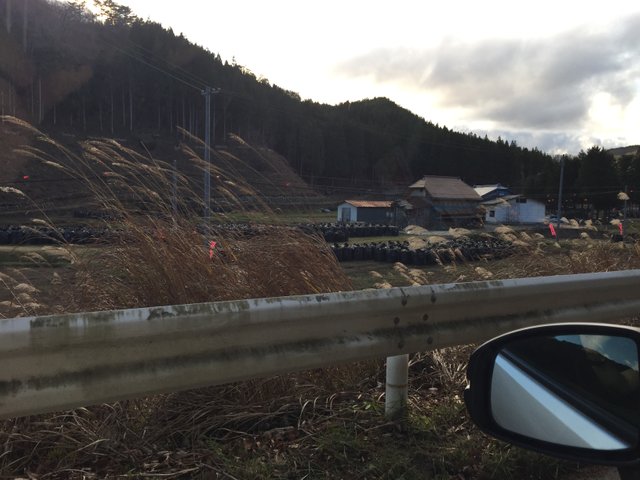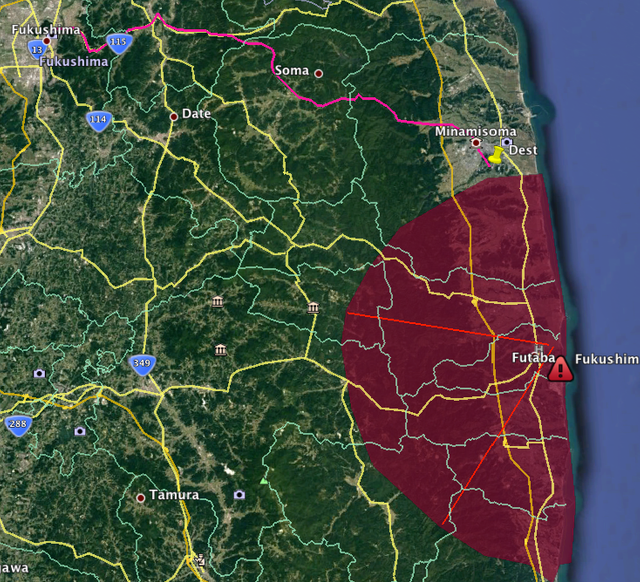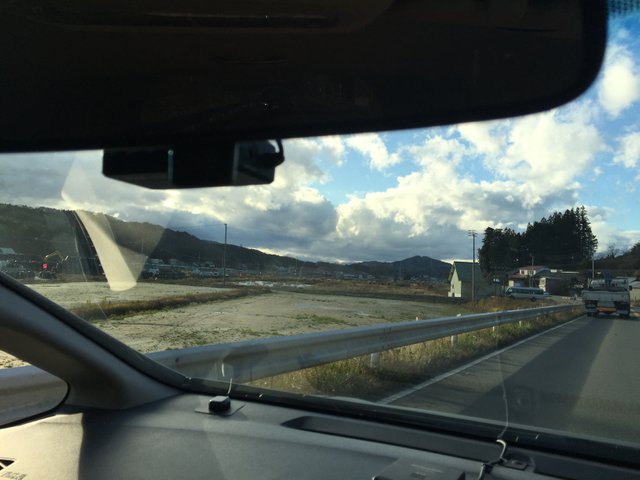The day I visited the Fukushima Daiichi Nuclear Plant exclusion zone limit

A view along the road- these houses were empty, a video can be seen below
In November 2015, I went to the northern areas surrounding the Fukushima Daiichi nuclear power plant. This is the story about that drive.
Firstly I would like to write a bit of a background to this story.
I had to visit this area for a work related assignment as I am a consulting solar consulting engineer and part of my assignment was to check the potential viability of new solar power plants in the area about 22km to the north of the actual nuclear power plant. I know, the irony! Can someone make a meme of a solar panel rising out of the ashes of a nuclear power plant that is melting down like the phoenix rising out of the ashes?
The day
I live in Tokyo, Fukushima Prefecture is actually huge, but the site that I was travelling to was located about a 2 hour bullet train ride up to the north of Tokyo plus another 1-2 hour drive to the east. So I arose early and prepared all of my gear which included drones, cameras, and backpacks and some long pants and hiking shoes. I arrived at Fukushima station and hired a car for the day. It was still about another 1.5 hour drive over to the north of the area that has been affected by the Daiichi Power plant meltdown on 3/11. The destination was actually about 22km north of ground zero, but actually getting there meant that I had to drive through some of the marginal areas that were about 20km to the north of the power plant. If you actually check the radiation maps from safecast you can see that prolonged exposure to these areas in above normal limits. I would actually be driving through some heavier fallout areas. But I'll get to that in the article.

The drive
Fukushima is actually a beautiful city and driving out of the city into the mountain resembles normalcy. Only after driving for about 1 hour to the east did I start to notice more and more construction trucks and construction workers. The amount of the trucks coming out of the area was growing rapidly as I approached the 60 km zone. I then started to notice a lot of construction workers digging up the fields and a lot of these guys were wearing white contamination suits and masks and goggles. Meanwhile I was driving along a normal road, with normal cars and trucks. Some of the trucks had passengers with these white contamination suits on, some didn’t.
At this point little red flags started popping up into my mind. S&%*- what the! I thought to myself. What have I dragged myself into this time? With any kind of moment like that you realize that it will pass. Anyway it actually was a passing moment and I drove on. At no stage did I hit any roadblocks or actual checkpoints.
A few things that I noticed;
- Solar powered geiger counters- These were positioned in periodic intervals along the road. You could read the live values of microSieverts quite easily from a distance.
- Mountains and mountains of black plastic bags filled with dirt- These stretched as far as the eye could see. Basically all of these construction workers had been scraping the top 1-2m of soil of the whole environment. That is all the fields, all the farms, all the road edges and basically everywhere. That’s why there were so many trucks and workers. In the area that I drove through alone there was about maybe an estimated 1000 workers.
The site visit
I won’t elaborate too much on this aspect, other than it was another successful consulting visit and the client was really happy with my report. I guess solar power can be the pheonix. I drove back to Fukushima safely, jumped back on a bullet train and arrived back in time for dinner. I made sure to scrub my clothes!
Some of my own conclusions
What have we done? What has allowed this to happen? There exists a good book written by the investigative journalist Mark Willacy called “Fukushima- Japan’s tsunami and the inside story of the nuclear meltdowns”. I highly recommend this book and it is well worth the read. Mark is a good investigative journalist and is trying to piece together the whole situation that led up the the actual disaster and some of the interviews that he was able to get done are really legendary. To even have access to some of the people that he was able to interview is a legend in itself.
In Japan, when big mistakes are made, there is a cultural tendency (not always negative as well). In this context to sweep things under the rug and forget about it and living day to day life in Tokyo, most citizens do actually forget about it most of the time. But, it is easily ignored and visiting the affected area made me realize this again, deeply. But things are changing.
For example, Safecast is an innovative project sponsored by the MIT Media lab to gather open source data about the radiation levels. They have just reached over 50 million data points. They have helped quantify what is really happening in the areas affected by the nuclear fallout.
I guess from my perspective it made me concentrate on my own practical work to promote distributed solar energy. Eventually that led me into SolarCoin and ElectriCChain for many reasons. I am still at a loss for words about what can actually be done about the elephant in the room that is Fukushima Daiichi power plant and surrounding areas. It is far from fixed. Yet, as @japannews explains Nuclear Plants are starting to reopen in the risky fault zones in Shikoku.
Some photos:

It is a daunting endeavor to put your life on the line like that once, which is extremely courageous; let alone do it regularly like Enson Inoue has since 2011:
Some of the ex-residents from Fukushima, those lucky enough to have relatives in the US, came to visit us in San Clemente during our crisis with San Onofre. Luckily we prevailed, which is an altogether unlikely victory, but only emboldened the best of us to make progress in meaningful change rather merely petition the State to shut it down--it wouldn't have happened despite being the power plant with the worst safety rating in all of the US following 3 mile island, had it not been for Mitsubishi's over-the-top level of incompetence and Edison's perpetual diffusion of responsibility and greed coming into the limelight so ungraciously.
I may make a post about that whole affair as I wrote it as it happened, dating back to 2007 when I became frighteningly aware of how absurd SONGS and nuclear power as whole really is and the often brushed away externalities.
Right, any chance I can get an invite to the Solarcoin slack? I'd really like to interact there as I'd like to pick the brain of some your most knowledgeable guys there. I've been doing bitcoin stuff since 2010, and just got into the solar industry; no alt has ever called my attention to date but I'm eager to learn about solarcoin.
Sidenote: I have family that are civil engineers and one of them was doing his undergrad with a professor who had been exploring the feasibility of getting Japan on geo-thermal in 2009-11 prior to Fukushima due to the large volcano presence here, from what I recall the research showed that if utilized it either matched or even exceeded the 30% nuclear dependence, but had a lot of bureaucratic redtape and sunk costs that made it unlikely.
Hi @ehcryptonerd- thanks for the concerns and well thought out comment.
Enson Inoue looks like a great and persistent guy. One thing I did notice is the massive impact that it has had on local residents and farmers. They are dealing with the externalities everyday. That is also not the first time I've visited the area, (probably the 30th or so) but still it is nothing to compare to what the residents have to deal with day in and day out.
It resonates with what we are trying to do. Sure, it is easy for anyone to join the solarcoin.slack and another really cool one the electricchain.slack.
Indeed, I was entirely lost for words when I heard that Japan had gone to great lengths, and then committed themselves to host the Olympics (Brazil this year really set the tone) and ramping up their military expenditures (to much local resentment) whilst the residents of the evacuation zone still remain in the fema-like housing situation. They are unlikely to address the matter in that time, too.
Yeah, the farmers are the ones who lost their entire livelihood, as you know they pushed the Eat Fukushima food agenda quite hard for a while, with what seemed to be some notable push back domestically. Internationally, though... it continues unabated I'm afraid via the same avenue the World over . What's worse is that if what local citizen journalists are reporting is true, this essentially created a new 'Buraku' caste as trying to migrate and assimilate into other prefectures is impossible.
Vitrification has been a useful means to contain the liquids/waste, but I'm afraid given the situation to date and despite these efforts it still won't solve the issue anytime soon.
See, I suck at social media stuff and usually avoid it al; together, but I'm on several Slacks but I thought you had to be invited to join as that is how I initially joined. I tried joining both but I got errors when I tried logging in with my credentials and the electricchain slack is stating I need to have a specific email domain from what i assume are partner institutions. What am I doing wrong?
Hi can you please contact us off this platform, then we can figure out how to add you into ElectriCChain. For example going over to BitCoinTalk and then messaging us.
Wow... I can't even remember the last time I logged into BTF, it has before the shutdown of SR; but, yeah I can do that.
Speak to you then.
Thanks for this, a very interesting post